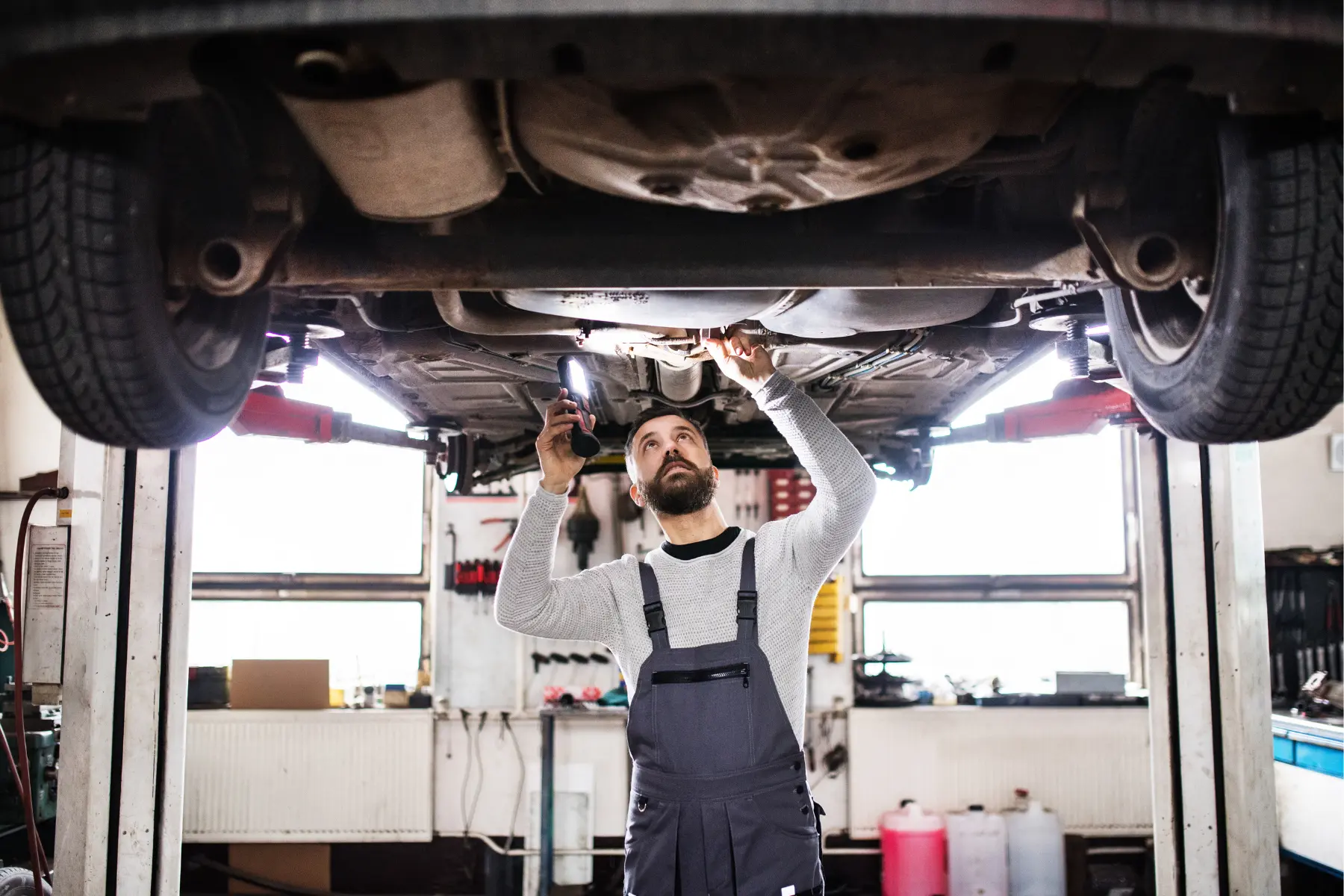About JC Whitney Editorial Team

Meet the JC Whitney Editorial Team, your go-to experts for automotive insights, from in-depth car culture articles to the latest in vehicle tech.
More from JC Whitney Editorial TeamUnderstanding the basics of auto parts is crucial for any car owner. These components are the building blocks of your vehicle, ensuring it operates smoothly and efficiently. From the engine and transmission to the brakes and suspension, each part plays a critical role in your car’s overall performance and safety. Regular maintenance and timely replacement of these parts can prevent breakdowns, extend the lifespan of your vehicle, and enhance driving safety. Familiarizing yourself with the fundamental aspects of auto parts not only helps you make informed decisions about your car’s upkeep but also empowers you to communicate more effectively with mechanics and service professionals.
Understanding Auto Parts and Their Functions
Key Auto Parts and Their Roles in Vehicle Operation
The engine, often considered the vehicle’s powerhouse, converts fuel into the energy needed to move the car. The transmission system, meanwhile, translates this energy into motion. Brakes are critical for safety, allowing the driver to stop the vehicle effectively, while the suspension system ensures a smooth ride by absorbing bumps and shocks. Understanding these components and their roles can significantly enhance your ability to maintain and troubleshoot your vehicle.
Signs That Indicate the Need for Part Replacement
Warning signs can vary but often include unusual noises, decreased performance, increased fuel consumption, and abnormal vibrations. For instance, squealing brakes might signal worn brake pads, while difficulty in steering could point to issues with the suspension or steering system. Being attuned to these signs and understanding what they could mean is crucial in preventing further damage to your vehicle.
How to Select the Right Parts for Your Vehicle
Selecting the right vehicle repair parts is vital to ensure compatibility and optimal performance. The vehicle’s make, model, and year are key factors in choosing the correct parts. It’s also important to consider the part’s quality and the manufacturer’s reputation. OEM (Original Equipment Manufacturer) parts offer guaranteed compatibility and reliability, though aftermarket parts can provide a cost-effective alternative with varying degrees of quality. Researching and consulting with trusted professionals can help you make informed decisions.
Essential Car Repair Tools
Basic Hand Tools Every Mechanic Should Have
For any mechanic, whether professional or DIY enthusiast, a set of basic car tools forms the foundation of any repair work. This set typically includes screwdrivers, wrenches, pliers, and hammers, which are indispensable for a wide range of tasks from tightening bolts to adjusting components. High-quality hand tools not only make the job easier but also ensure safety and precision.
Specialty Tools for Specific Repair Jobs
Beyond the basics, there are specialty tools designed for specific repair jobs that can significantly enhance the efficiency and effectiveness of your work. Examples include torque wrenches for applying precise force, OBD-II scanners for diagnosing electronic issues, and brake caliper tools for servicing the braking system. These specialized tools might require a larger initial investment but can save time and frustration in the long run, making them invaluable for those tackling more complex repairs.
Investing in Quality Tools for Longevity
Investing in quality tools not only ensures that you can perform repairs efficiently but also reduces the risk of tool failure during a job. Quality tools are typically made from superior materials, offer better ergonomics, and come with warranties, representing a long-term investment in your repair capabilities.
Organizational Tips for Your Tool Collection
Keeping your car repair and maintenance tools organized is crucial for efficient and effective work. A well-organized tool collection saves time, prevents loss, and extends the life of your tools by ensuring they are stored properly. Here are some organizational tips for your tool collection:
- Use a Tool Chest or Cabinet: Investing in a high-quality tool chest or cabinet with multiple drawers provides a centralized location for your tools, protecting them from dust, rust, and physical damage. This storage solution is ideal for categorizing tools and keeping them secure.
- Label Drawers: Take the organization a step further by labeling each drawer according to the type of tools or their function. You may easily find what you need with this method and avoid having to search through several drawers, which saves you a lot of time.
- Employ Wall Storage: Utilizing wall space with pegboards and magnetic strips is an excellent way to keep frequently used tools accessible.
- Utilize Tool Foam: Customizable tool foam can be cut to fit the shapes of specific tools, ensuring each item has a designated spot. This not only prevents tools from moving around and getting damaged but also makes it immediately obvious when a tool is missing.
- Implement a Checkout System: For those who share their tool collection with family members or friends, establishing a simple checkout system can help track tool usage. By ensuring that every tool is put back in its proper location after usage, accountability, and organization are upheld.
- Regular Cleaning: Keeping your tools and their storage areas clean is essential for prolonging their life and maintaining their performance. Regular cleaning prevents the buildup of grease, dust, and debris, which can cause damage over time.
- Periodic Inventory: Conducting a periodic inventory of your tools allows you to identify any missing items promptly and assess whether your organizational system needs adjustments. It’s also a good opportunity to reorganize your tools based on usage patterns or new acquisitions.
Adopting these organizational strategies can transform your workspace into a more productive and enjoyable environment, ensuring that your auto repair toolset is always ready for the task at hand.
Car Maintenance Tools for Effective Upkeep
Must-Have Tools for Regular Vehicle Maintenance
These include oil filter wrenches for oil changes, tire pressure gauges to ensure optimal tire health and battery testers to monitor the condition of your vehicle’s battery. Also crucial are spark plug socket sets and a reliable jack with jack stands for safely lifting and supporting your vehicle.
Maintenance Tools for Engine Health
Maintaining your engine’s health is crucial for the longevity of your vehicle. Tools specifically designed for engine maintenance, such as compression testers to check the engine’s cylinder compression and timing lights for adjusting the ignition timing, are critical. Additionally, a cooling system pressure tester can detect leaks in the cooling system, preventing overheating issues.
Importance of Proper Tool Maintenance
Proper tool maintenance is crucial for anyone who relies on tools for work, hobbies, or general home repair. Maintaining your tools can significantly extend their useful life, improve job efficiency, and enhance safety during use. Well-maintained tools perform better and are less likely to fail or cause accidents. Here’s how you can keep your tools in top condition:
- Clean After Use: Cleaning your tools after each use is fundamental. Removing dirt, grease, or debris with a clean cloth and applying appropriate cleaners for more stubborn grime prevents buildup that can lead to corrosion. This simple step keeps your tools in optimal working condition and ready for their next use.
- Lubricate Moving Parts: For tools with moving parts, regular lubrication is key to preventing rust and ensuring they operate smoothly. Applying a few drops of machine oil to the joints and moving components can prevent wear and tear, maintaining the tool’s functionality over time.
- Inspect for Damage: Conduct regular inspections of your tools for any signs of wear or damage, such as cracks, splinters, or bent metal. Such damage can compromise the safety and integrity of the tool, making it hazardous to use. Promptly replace or repair damaged tools to maintain your toolkit’s reliability and safety.
- Sharpen Cutting Tools: Keeping cutting tools sharp is crucial for both efficiency and safety. Dull blades require more force to use, increasing the risk of accidents. Regularly sharpening blades with a stone or a tool-specific sharpener ensures they cut effectively and safely.
- Handle With Care: Tools should always be used for their intended purpose and handled with care. Misusing tools, such as employing them as makeshift hammers or pry bars, can lead to damage and wear. Using tools correctly extends their lifespan and prevents damage to the workpiece.
- Check Calibration: Precision tools, such as torque wrenches, require correct calibration to function accurately. To make sure the tool works as intended, periodically verify and modify the calibration following the manufacturer’s instructions. This is crucial for jobs that call for exact measurements or adjustments.
Implementing these maintenance practices ensures that your tools remain reliable, safe, and ready to perform when you need them. This proactive approach not only saves you money by extending the lifespan of your tools but also contributes to a safer and more efficient working environment, whether you’re a professional tradesperson, a dedicated DIYer, or an occasional home repair enthusiast.
Choosing Vehicle Repair Parts Wisely
OEM vs. Aftermarket Parts: Pros and Cons
When it comes to auto parts, vehicle owners are often faced with the choice between OEM (Original Equipment Manufacturer) and aftermarket options. OEM parts are made by the vehicle’s manufacturer, guaranteeing a perfect fit and proven quality, but often at a higher cost. Aftermarket parts, produced by third-party companies, offer a more affordable alternative and can provide equal or superior performance in some cases. However, the quality of aftermarket parts can vary widely. Weighing the pros and cons, including cost, availability, and warranty considerations, is crucial when deciding which type of part is best for your needs.
Tips for Sourcing Reliable Vehicle Parts
Online forums and automotive communities can also offer valuable insights based on collective experiences. When purchasing parts, choose reputable suppliers who offer guarantees or return policies. Checking reviews and ratings can help you measure the reliability and performance of both the parts and the sellers. Always verify the compatibility of the parts with your vehicle to avoid the hassle and expense of incorrect or substandard components.
Advanced Car Mechanic Tools
Diagnostic Equipment for Comprehensive Analysis
These sophisticated tools, such as graphing multimeters, oscilloscopes, and manufacturer-specific scanners, can pinpoint issues that are not apparent through traditional diagnostics. This equipment can assess the functionality of various systems, including electrical, fuel injection, and emissions, providing detailed feedback that informs more effective and efficient repairs. For the DIY mechanic, investing in these tools can elevate the ability to maintain and repair vehicles to a professional standard.
Professional-Grade Tools for DIY Repairs
Utilizing professional-grade auto repair equipment in DIY repairs can offer numerous benefits, including enhanced accuracy, efficiency, and safety. These tools are designed to withstand the rigors of frequent use and can handle more complex tasks than basic tools.
Expanding Your Toolkit
Deciding when and what to upgrade in your auto mechanic tools set can significantly impact your repair capabilities. As your skills and confidence grow, you might find that basic tools no longer meet your needs for more specialized or complex jobs. Upgrading to advanced tools should be based on the types of repairs you frequently undertake and the specific needs of your vehicle(s).
By continuously seeking to improve, you can master the world of auto repair and maintenance, ensuring your vehicle remains in peak condition for years to come. Whether you’re a seasoned mechanic or a dedicated DIY enthusiast, the journey of learning and improvement never ends. Embrace the challenges and rewards that come with automotive maintenance and repair, and enjoy the ride.
